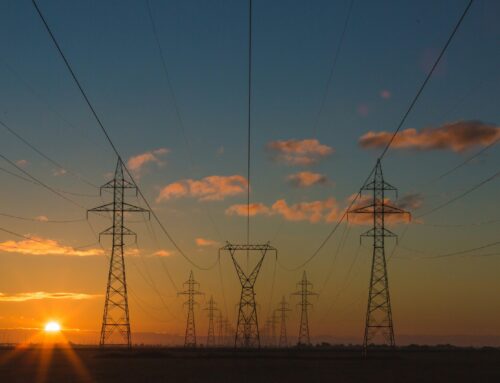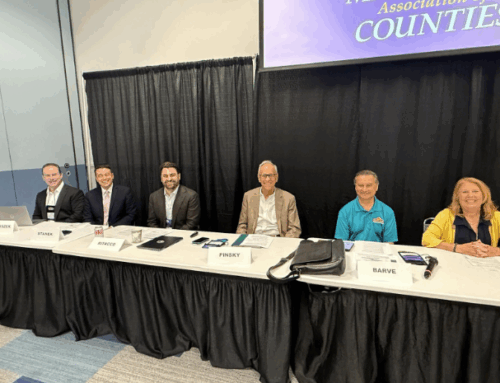South Texas data center to use untapped windfarm energy
October 21, 2025
Subscribe to The Y’all — a weekly dispatch about the people, places and policies defining Texas, produced by Texas Tribune journalists living in communities across the state.
WILLACY COUNTY — Scattered across the acres of open fields, dozens of wind turbines stood tall one morning last month, some moved their blades with the wind as designed. Others didn’t move at all.
The inactivity at the Las Majadas Wind project was by design. This set of windmills in the Rio Grande Valley were generating more power than could be used. Now one company has a plan to bring those turbines to life.
Soluna Holdings, a data center developer focused on using renewable energy, broke ground on its data center here that will be used to manage data for Bitcoin hosting and artificial intelligence. Data centers have sprung up across the state, housing servers and infrastructure that store and process our online activity. Their growth has been spurred, in part, by the growing use of AI.
As data centers face scrutiny over the energy required to power these facilities, as well as the water needed for their cooling systems, this facility is meant to circumvent waste by utilizing energy that would otherwise go unused.
“It became clear to us that there’s lots of energy out there. Lots of it is wasted,” Belizaire said. “And if you tap into that wasted energy, you actually can power this next revolution without materially reshaping the trajectory of our climate.”
Power is wasted, or “stranded,” largely because of insufficient infrastructure, according to Jeff Clark, president and CEO of Advanced Power Alliance, a group that advocates for renewable energy.
Clark said the state’s grid hasn’t kept pace with where new generation is being built. In particular, there aren’t enough transmission lines to deliver power to high demand areas, especially power generated in rural Texas
“Until new transmission lines are built to connect the two, the power that could be generated in those regions often has nowhere to go,” Clark said.
This new data center, Project Kati, is an example of what’s referred to as a flexible load — a facility that can ramp up or down its power use based on grid conditions. And its location near where power is being generated means it won’t require the use of long-distance transmission lines.
At peak capacity, the data center will use 166 mega watts of energy — about 16 times the estimated use of AT&T Stadium on game day, according to a 2013 report. The first phase will be built to deliver 83 megawatts of computing capacity for Bitcoin. The second 83 megawatt expansion will support artificial intelligence and high-performance computing.
Soluna hopes to have part of the facility running in December with plans to complete the first phase in June or July.
Las Majadas Wind project, the farm that will power the datacenter, is co-owned by EDF Renewables North America and Masdar, a renewable energy company based in the United Arab Emirates.
Las Majadas is one of a handful of wind energy projects located in Willacy County, a county of little more than 20,000 people on the northeast corner of the Rio Grande Valley. Its largely rural landscape with wide open fields makes it an ideal location for such projects which include the Los Vientos wind farm, one of the largest wind projects in the country.
Willacy County Judge Aurelio “Keter” Guerra said securing these projects is an every day effort to allow their small county to prosper.
Soluna estimates the project will create 18 permanent, direct jobs within the first two to three years during the first phase. They expect an additional 75 jobs during the construction phase.
Regardless of the number of jobs created, Guerra said those positions will be high-paying. And, the most important benefit, he said, is the taxable value that it will bring to the county.
“Value is how counties survive,” he said. “Unlike cities that depend more on sales (taxes), counties depend more on value, and so these types of projects bring in value.”
He added, “For a small county like ours that operates on a $9 million budget, I think it’s great.”
Texas is uniquely positioned to see more of these types of projects.
Eric Gimon, a senior fellow with Energy Innovation, a nonpartisan energy and climate policy think tank, said using “stranded” renewable energy is much easier to do in Texas because of favorable rules set by the Electric Reliability Council of Texas.
Such policies include netting, which allows data centers to consume energy directly from the power generator, avoiding fees from ERCOT for using power from the grid.
Texas also allows “sleeving” which is when an intermediary retailer sells renewable energy from the generator to the buyer for a fee, allowing buyers to purchase energy at a negotiated price.
The benefit of cost stability is significant for data centers to secure the energy they need at a price they can afford through a long-term, predictable contract even in times of high market volatility.
Those benefits could play a role in drawing more data centers to the state that could make use of stranded energy.
Clark said electricity demand is expected to double over the next 10 years all across the country. To meet that demand, he said it will take collaboration among solar, wind, natural gas, nuclear, and energy storage technologies.
“The vision we have is an ‘all-of-the-above’ power mix — every resource working together to meet growing electricity demand,” Clark said. “Projects like this one in Willacy County are just the beginning of how flexible, innovative solutions can strengthen our grid and grow local economies.”
Gimon also expects to see more partnerships as more data centers take advantage of wind farms that are being underutilized.
“It is definitely a signal of things to come,” Gimon said. “There is not enough power to power up all the data centers that want to get built; you can’t build it fast enough.”
Reporting in the Rio Grande Valley is supported in part by the Methodist Healthcare Ministries of South Texas, Inc.
Disclosure: Advanced Power Alliance has been a financial supporter of The Texas Tribune, a nonprofit, nonpartisan news organization that is funded in part by donations from members, foundations and corporate sponsors. Financial supporters play no role in the Tribune’s journalism. Find a complete list of them here.
Search
RECENT PRESS RELEASES
Related Post



